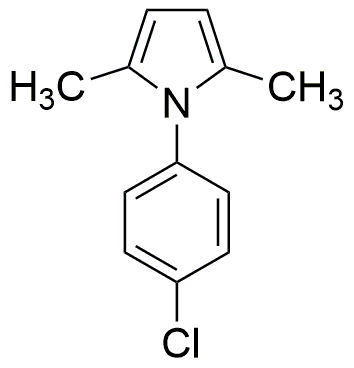1-(4-Chlorophenyl)-2,5-dimethylpyrrole is widely utilized in research focused on:
- Pharmaceutical Development: This compound serves as a key intermediate in the synthesis of various pharmaceuticals, particularly in the development of anti-cancer agents, due to its ability to interact with biological targets effectively.
- Agricultural Chemicals: It is used in formulating agrochemicals, including pesticides and herbicides, offering enhanced efficacy in controlling pests while minimizing environmental impact.
- Material Science: The compound is explored in the creation of advanced materials, such as conductive polymers, which are essential in electronics and energy storage devices.
- Research in Organic Chemistry: It acts as a versatile building block in organic synthesis, enabling chemists to create complex molecules with specific properties for various applications.
- Biochemical Research: The compound is employed in studies investigating enzyme interactions and metabolic pathways, providing insights that can lead to novel therapeutic strategies.
Informations générales
Propriétés
Sécurité et réglementation
Applications
1-(4-Chlorophenyl)-2,5-dimethylpyrrole is widely utilized in research focused on:
- Pharmaceutical Development: This compound serves as a key intermediate in the synthesis of various pharmaceuticals, particularly in the development of anti-cancer agents, due to its ability to interact with biological targets effectively.
- Agricultural Chemicals: It is used in formulating agrochemicals, including pesticides and herbicides, offering enhanced efficacy in controlling pests while minimizing environmental impact.
- Material Science: The compound is explored in the creation of advanced materials, such as conductive polymers, which are essential in electronics and energy storage devices.
- Research in Organic Chemistry: It acts as a versatile building block in organic synthesis, enabling chemists to create complex molecules with specific properties for various applications.
- Biochemical Research: The compound is employed in studies investigating enzyme interactions and metabolic pathways, providing insights that can lead to novel therapeutic strategies.
Documents
Fiches de données de sécurité (FDS)
La FDS fournit des informations de sécurité complètes sur la manipulation, le stockage et l’élimination du produit.
Spécifications du produit (PS)
Le PS fournit une description complète des propriétés du produit, notamment sa composition chimique, son état physique, sa pureté et les exigences de stockage. Il détaille également les plages de qualité acceptables et les applications prévues du produit.
Certificats d'analyse (COA)
Recherchez des certificats d'analyse (COA) en saisissant le numéro de lot du produit. Les numéros de lot et de lot se trouvent sur l'étiquette d'un produit, après les mots « Lot » ou « Lot de fabrication ».
Numéro de catalogue
Numéro de lot/série
Certificats d'origine (COO)
Ce certificat d'exploitation confirme le pays dans lequel le produit a été fabriqué, et détaille également les matériaux et composants utilisés et s'il est issu de sources naturelles, synthétiques ou autres sources spécifiques. Ce certificat peut être requis pour les douanes, le commerce et la conformité réglementaire.
Numéro de catalogue
Numéro de lot/série
Fiches de données de sécurité (FDS)
La FDS fournit des informations de sécurité complètes sur la manipulation, le stockage et l’élimination du produit.
DownloadSpécifications du produit (PS)
Le PS fournit une description complète des propriétés du produit, notamment sa composition chimique, son état physique, sa pureté et les exigences de stockage. Il détaille également les plages de qualité acceptables et les applications prévues du produit.
DownloadCertificats d'analyse (COA)
Recherchez des certificats d'analyse (COA) en saisissant le numéro de lot du produit. Les numéros de lot et de lot se trouvent sur l'étiquette d'un produit, après les mots « Lot » ou « Lot de fabrication ».
Numéro de catalogue
Numéro de lot/série
Certificats d'origine (COO)
Ce certificat d'exploitation confirme le pays dans lequel le produit a été fabriqué, et détaille également les matériaux et composants utilisés et s'il est issu de sources naturelles, synthétiques ou autres sources spécifiques. Ce certificat peut être requis pour les douanes, le commerce et la conformité réglementaire.


